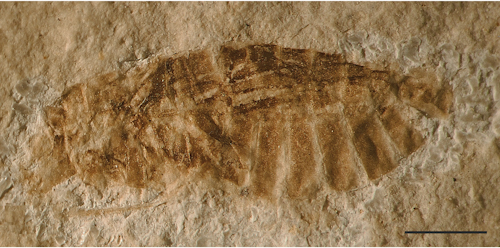During the course of two field expeditions in 2012 and 2013, French researchers working with the help of two active teams of amateur scientists (Société des Naturalistes et Archéologues de l’Ain and the Group ‘Sympetrum Recherche et Protection des Libellules’) discovered the first Upper Jurassic insects from the Orbagnoux outcrop, together with traces of activities of these organisms on leaves and in the sediment. The newly discovered insect was described today, in PeerJ.
We were interested in learning more about this work, so we invited the first author, André Nel, to comment on his research and his experience publishing with us.
 PJ: Can you tell us a bit about yourself?
PJ: Can you tell us a bit about yourself?
AN: I am a Professor at the Muséum national d’Histoire naturelle in Paris, France. I study fossil insects, and I’ve been working on this subject since 1980.
PJ: Can you briefly explain the research you published in PeerJ
AN: We worked on the marine limestone in the area around Orbagnoux (France) and recorded the first Upper Jurassic insects and the traces of their activities. Although such fossils are well known in Siberia, China, and Germany, none had been identified in our country until now.
PJ: Do you have any anecdotes about this research?
AN: This area of the French Alps was well known for their fish and plant fossils, but no one had ever looked for insects around there. A friend of mine (Claire Griot) lives there, but I never had the opportunity to go and visit the site. She contacted me three years ago and invited me to explore the site, just in case there would be something. So this is really thanks to her that this discovery happened! It’s also through the great help of the very active local naturalists and citizen scientists in the field that we found this new material.
PJ: What surprised you the most with these results?
AN: To be honest, I didn’t believe we would find something on site! Not a single insect fossil has been recorded in this area since the first paleontological investigations in the 19th century!

Fossilized aquatic bug from the Orbagnoux outcrop of the Rhone valley: Gallomesovelia grioti (scale bar 1 mm) – Photo:André Nel
PJ: What kinds of lessons do you hope the public takes away from the research?
AN: A collaboration between scientific researchers and citizen scientists is an asset, and it helps towards finding extraordinary new data for science.
PJ: Where do you hope to go from here?
AN: We want to look for new material! Earlier this year, we went back to Orbagnoux and we found a new type of insect activity on plant fossils (and maybe new insects that we are currently studying).
PJ: If you had unlimited resources, what study would you run?
AN: There are many outcrops that are not well studied due to the lack of resources. I would hire a highly motivated research assistant, and I would encourage the search for fossil insects in France. Palaeoentomology is not an expensive science, and it can give quite important new data on the evolution of continents and life, as insects constitute about 60-70% of the world biodiversity.
PJ: Why did you choose to reproduce the complete peer-review history of your article?
AN: I am convinced that this manuscript is the result of an active interaction between citizen scientists, scientific researchers, and reviewers. We wanted to make the review process as transparent as possible, so everybody could have access to it.
PJ: How did you first hear about PeerJ, and what persuaded you to submit to us?
AN: A colleague in our lab, Philippe Grandcolas, is an Academic Editor for PeerJ and highly recommended us to submit our manuscript to PeerJ.
PJ: How would you describe your experience of our submission/review process?
AN: The process was quick and friendly.
PJ: In conclusion, how would you describe PeerJ in three words?
AN: Active promising journal
PJ: Many thanks for your time!
If you also like bigger fossils, check out some of our Paleontology publications in PeerJ. We have thousands of highly satisfied authors. If you would like to experience the PeerJ process for yourself, then submit your next article to us!

